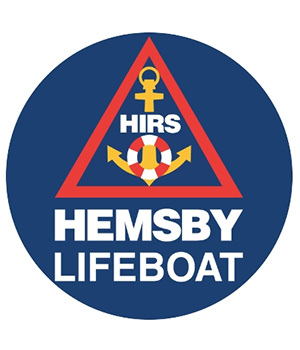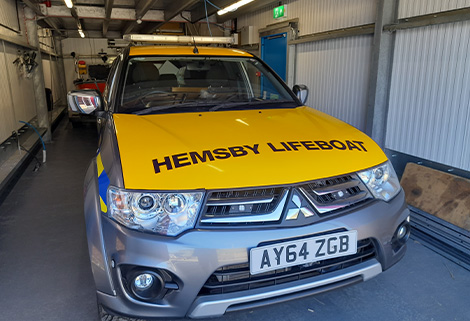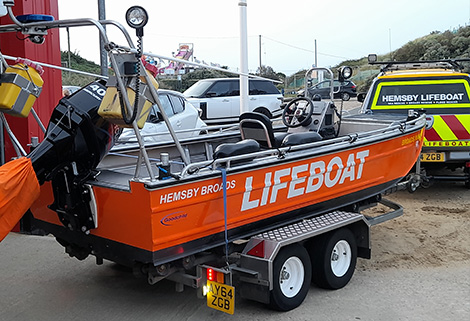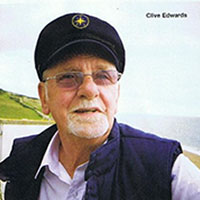lifeboat for the broads
 The story of the “Lifeboat for the Broads” really began in 1999 when following a call from Great Yarmouth Coastguard requesting the inshore inflatable lifeboat stationed on the coast at Hemsby to attend an incident several miles inland on Hickling Broad.
The story of the “Lifeboat for the Broads” really began in 1999 when following a call from Great Yarmouth Coastguard requesting the inshore inflatable lifeboat stationed on the coast at Hemsby to attend an incident several miles inland on Hickling Broad.
The Hemsby crew responded of course, even though to get to the scene of the incident meant having to tow the lifeboat several miles by road (courtesy of a local farmer) to a launching slip on the shore at Hickling Broad.
Although that was the first recorded incident of Hemsby Lifeboat having been tasked by the Coastguard to attend an incident on the Broads, the history of Hemsby Lifeboat station itself actually began many years previously in the early 1970s, following more than a dozen fatalities as a result of drowning along the coastal waters between Winterton and Scratby. The nearest lifeboats were an RNLI “D” class 5m inflatable at Happisburgh to the north and an old Liverpool Class all weather lifeboat capable of no more than about 8kts based at Caister to the south.
The result of these drownings was a commitment in 1975 by the local Hemsby community to form a local Rescue Service and to source an appropriate “rescue boat” in the shape of a 4.5m Avon inflatable on loan from Sub Aqua club. Later that year, thanks to the generosity of the Norfolk Broads Lions Club, The Hemsby Inshore Rescue Service (HIRS) was able to purchase their first boat, a 5m Avon Searider RIB with a 40hp Mercury outboard, appropriately named “Sealion 1” in recognition of the Lions Club’s support.
Following the purchase of their own rescue boat there was of course a need to source a boat-house to keep it in, but even more importantly to site this in a position that enabled the boat to be launched as quickly as possible in the event of a “shout”. There was of course then a pressing need to equip the boat with essential kit such as life-jackets, VHF radio etc and to recruit volunteers to act as crew for the new boat and most importantly to provide training in seamanship, radio communications and first-aid for the boat and shore crews who initially numbered around thirty volunteers. In their very first year the Hemsby inshore rescue service responded to six incidents (nowadays usually referred to as “shouts”)
The next years, 1977 and 1978 were busy with all the administrative measures required for recognition by the Charity Commission, HM Coastguard and operational matters as well including the purchase of a Landrover for launching the rescue boat into the water, pagers for the crew, whilst during that same two-year period the HIRS responded to no less than 19 “shouts”
The1980s saw many developments amongst the most significant being the official recognition by HM Coastguard of Hemsby IRS as a “Declared Facility” and an integral part of the UK Search & Rescue organisation (UKSAR) Declared Facility Status, or DFS as its usually referred to is not an accolade that’s hard to achieve it also requires the station to conform to the Coastguard Code of Practice covering its range of operations and procedures, all of which are monitored annually by the Maritme & Coastguard Agency (MCA)
Other notable events during the 1980s and ‘90s included the building of a new purpose-built station building, the purchase of new boats Sealions ll, III and lV all against a worrying background of coastal erosion. During the two decades of the ‘80s and ‘90s Hemsby Inshore Rescue Services responded to more than eighty “shouts” culminating in 1999 with that incident described previously, several miles inland on Hickling Broad. This incident lead to a decision to purchase a dedicated “freshwater lifeboat” for use on inland waters, mainly of course for incidents on The Broads, where a shallow draft boat is needed and the usual RIB with its relatively deep hull designed for use at sea, often in rough weather, is really not best suited to the often quite shallow waters of the Broads.

So the turn of the century saw the introduction of the very first Hemsby Broads Rescue Boat, subsequently superceeded by similar types of boat culminating some few years ago with a 14 foot Seastrike/Goodchild Marine very shallow draft aluminium “dory” powered by a 30hp outboard and normally towed to one of some 32 launching sites around the 125 miles of the Broads inland waterways by a Mitsubishi L20 tow truck

This Broads Rescue Boat, known more commonly as the Lifeboat for the Broads, responds to an average of some 50 incidents on the Broads every year, while Hemsby’s sea-going RIB lifeboat also gets numerous shouts each year for incidents offshore, all made more difficult in terms of launching by the serious and on-going coastal erosion here which deserves far more from the government in terms of improved sea defences which if not forthcoming will result in the need for the whole Hemsby Lifeboat Station and its operations to be relocated.

An example of the type of “shouts” that the Hemsby Lifeboat for the Broads responds to took place earlier this month as described in the local press:
“Hemsby Broads Rescue was paged by Humber Coastguard last night at 23:40. Our assistance was requested by local Coastguard teams to help with the evacuation of a female in her seventies who had fallen on her vessel earlier in the evening.
It was agreed by the Coastguard and the medical team on scene that the best option would be to navigate the vessel to a suitable mooring close to the Ambulance, as the alternative would have been a significant walk and not in the best interests of the casualty or emergency crews.
We launched Broads Marley and, after locating the casualty vessel, put two crew on board to navigate to the selected mooring close to the ambulance. Helmed by a lifeboat crew, the vessel proceeded under escort from the Broads Rescue Boat and was safely repositioned.
We thank the Coastguard teams from Bacton and Winterton and the Ambulance Crew. Once the casualty was safe on board the ambulance Hemsby Stood down and returned to base for post-emergency administration and clean down at 01:45."

